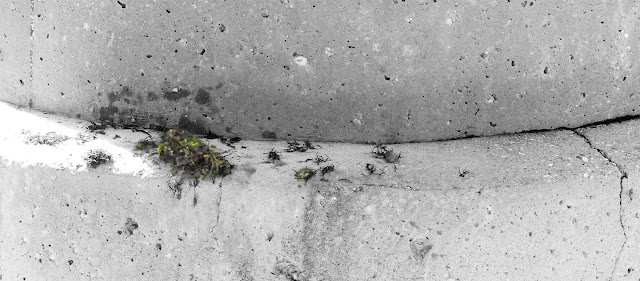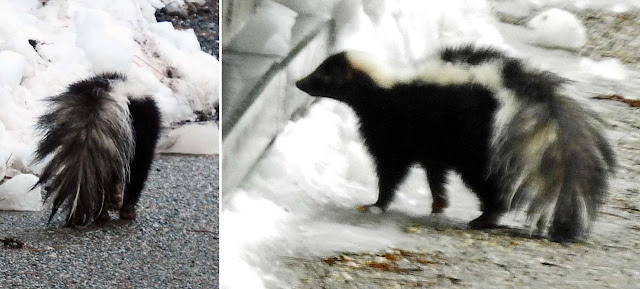American Dipper - Cinclus mexicanus
All Winter long I've been hearing the songs of American Dippers on our river. Sometimes the songs have a tinkling, bell-like quality! They were John Muir's favorite bird, and are the only aquatic songbird in North America!
They live here year-round, diving underwater to eat aquatic insects and larvae as well as tiny fish. They have powerful legs, long toes (NOT webbed) and streamlined bodies that makes walking on underwater rocks, in swift currents, possible. They also swim underwater using their wings like flippers and their tail like a rudder. With a heavy coat of oil on their outer feathers coupled with a dense coat of downy feathers underneath, Dippers can tolerate the frigid winter river. They have twice as many feathers as any songbird their size, even their eyelids are feathered! As they dive under the water, special scales slide to cover their nostrils and nictitating membranes cover their eyes! The membranes are hinged at the inner side of the eyes and sweep horizontally across the corneas. The scales keep water out of the Dipper's nose, and the membranes make it possible for it to see underwater.
American Dipper with nest building material - Cinclus mexicanus
While I was hiking along the river this week, I came across a pair of American Dippers just starting to build their nest! Now that's a sure sign of Spring! Both the male and the female were gathering clumps of moss and grasses, and arranging them on the shelf of a highway pillar in the river!
Dipper nest beginning
I've come across completed Dipper nests before, but have never seen the beginning of one! I watched them fly in and out with more and more plants for a few minutes, and then continued on my hike.
When I came back, about 40 minutes later, I was amazed at how much they had already built up their nest! It looks like they were making the exterior outline of the nest first! It's that curved semi-circle, with a pile of "building materials" to the right! I am astonished that they can work together on the same plan and build a nest together. What a wonder to watch!
Both the male and the female build the nest, but the female does most of the construction. Their completed nest will be large (12" wide - 8" diameter), igloo-shaped, and consist of an inner nest made from woven grasses, leaves, and bark, and an outer shell of moss. It will also have a semi-roofed entrance!
I couldn't find the exact length of time it takes for them to build a nest, but I would imagine it would be at least several days. I will go back every day this week and watch how they construct their nest, and how long it takes!
This nest was built on the ledge of a bridge pillar, out in the river, about 20' above the river. The Cornell Lab of Ornithology states:
"Natural sites commonly include cliff ledges and cliffs, behind waterfalls, under boulder piles, midstream boulders. Occasionally among roots, in hollow tree stumps, and under overhanging dirt banks. Readily uses human-made structures: under bridges, dam spillways and sluiceways, culverts, and buildings. Uses nest boxes placed on midstream stake or under bridge, if inaccessible to predators. Basic requirements for nest sites: close to water (usually fast water, usually with high noise level), inaccessible to predators, protected from floods, and a horizontal ledge or crevice for support. Locations close to fast water or deep water augment inaccessibility."
Brewer's Blackbird (male) - Euphagus cyanocephalus
Another sign of Spring is the return of the Brewer's Blackbirds to our neighborhood. A few males showed up just this week! They spend their winters in California's San Joaquin Valley, and other lower-elevation sites. They will stay here through the Summer, mate, and help raise their young.
Brewer's Blackbird (male) - Euphagus cyanocephalus
Males are quite possessive and protective of their mates. I've often seen them puff up their chest and feathers, but I'm not sure for what purpose. Perhaps it is done to warn off interlopers!
Brewer's Blackbird (males) - Euphagus cyanocephalus
I did see two male Brewer's Blackbirds aggressively confront each other one time! It only lasted a minute or so! Mainly they raised their beaks while pressing their chests against each other! Their pupils were also really constricted! Perhaps they were competing for the same female!
Anna's Hummingbird (female) - Calypte anna
Down where the Manzanitas are in bloom, I spotted this little Anna's Hummingbird this week. It's the first one this year! There are lots and lots of blossoms to feed on right now, and many buds yet to open. These beautiful hummers spend the winter in the lower elevations of California and Arizona. They return to our neighborhood and even higher elevations in the Spring, to breed and raise their young.
California Tortoiseshell Butterfly (topside & underside) - Nymphalis californica
Surprisingly I've seen California Tortoiseshell Butterflies flitting around our neighborhood this week! These butterflies overwinter as adults, and are ready to mate and lay their eggs as soon as the temperatures warm up!
Greater Bee Fly - Euphagus cyanocephalus
The Greater Bee Fly overwinters as a pupa. Once it hatches in the Spring, it is out looking for nectar to eat. Flying from flower to flower, they are important pollinators in the native plant world! I found this one in the patch of blooming Manzanitas down the highway!
Frog Embryos
I found another sign of Spring in the roadside ditch last week, frog embryos! I only found a small number of them, but more should be become apparent as the temperatures warm up. These tiny beings will gradually change into adult frogs in a month or more!
Gray Fox - Urocyon cinereoargenteus
Local Mammals
Feeding the birds this winter has been a lot of fun! I love seeing new species show up, and often it's not a bird species! Several mammals seem to find bird seed very edible! This beautiful Gray Fox shows up in our backyard almost every evening and patiently eats leftover birdseed! What a beauty!
Gray Fox - Urocyon cinereoargenteus
The snow is melting away pretty quickly, and exposing the bare, damp, ground. I was amazed how camouflaged this fox was while it was eating the seed. Background matching, in which a species conceals itself by resembling its surroundings, is the most common form of camouflage. Countershading is often used as part of the background matching tactic. Being darker on top and lighter underneath (countershading), the solid body shape is broken up and more difficult to see.
Chickaree or Douglas Squirrel - Tamiasciurus douglasii
Another seed lover is the Chickaree. These squirrels remain active all winter. They will store some food for the winter, but will also seek it out. I don't know if you remember, but last Fall one of these Chickarees was busy cutting off the seed-filled, dried, Sunflower heads in our garden and carrying them away!
Western Gray Squirrel - Sciurus griseus
This Gray Squirrel also loves the bird seed, especially the sunflower seeds. We see it almost every day now in our backyard. It too remains active all winter, and stores some food to survive the snowy season.
Striped Skunk - Mephitis mephitis
Striped Skunks are primarily nocturnal, so I was surprised to see this one on a snowy day! These skunks don't hibernate, rather they eat mice, shrews, and dormant insects, and yes, birdseed in the winter. If it's really terrible weather, they will plug their underground burrows, lower their body temperature, and drop into a semi-hibernated state for a while.
We had another rainy week with a precipitation total of 2.15", bringing our Water Year total to 74.72"! More rain and snow is predicted for this coming week. Hopefully we'll get some sunshine this weekend before the next weather system moves in! We spotted this gorgeous rainbow yesterday, on the way home in the rain!
What's happening down in the foothills?
What new birds are going to arrive?
Have the willows blossomed?
Check back next week for the answers to these questions and more!
Unfortunately, you can no longer sign up to get my blog via email. Just go to northyubanaturalist.blogspot.com directly.
Your questions and comments are greatly appreciated. Please feel free to email me at northyubanaturalist@gmail.com. Thanks!
.jpg)







.jpg)
.jpg)




.jpg)



No comments:
Post a Comment